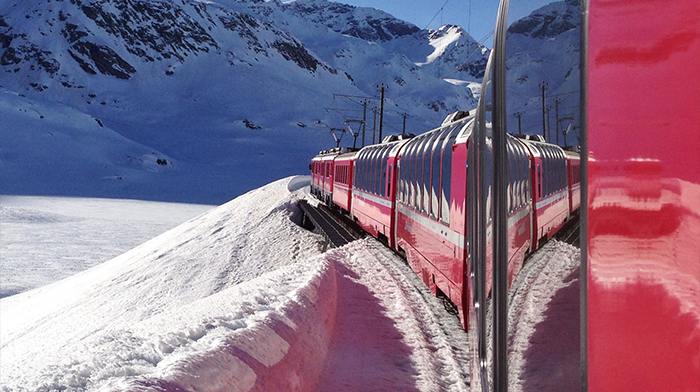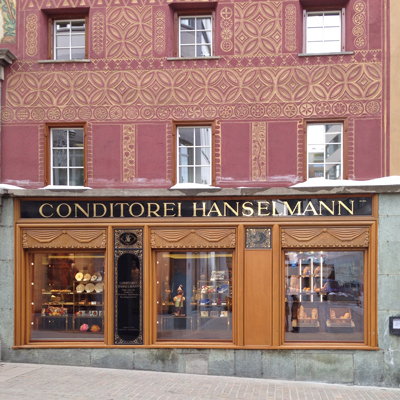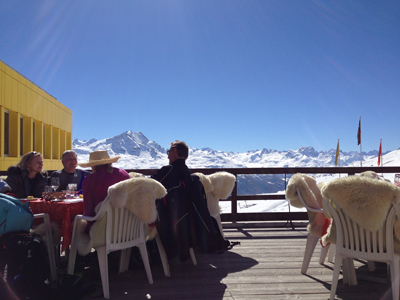
Two days in St. Moritz is never enough. Switzerland’s Engadin Valley is a constantly blossoming garden of sporting and cultural activities and gastronomical delights. Beginning as a healing destination for pilgrims, St. Moritz was a summer spot until hotel pioneer Johannes Badrutt invited his British guests there one winter in the mid-1800s. Since then, it has been developed and curated as a luxurious winter getaway. Whether you choose to go in the warm or cold season, here’s what to do:
Day One
Getting in and out of St. Moritz is perhaps the most charming part of your trip and should only be done by train. The Bernina Express is the 74.5-mile railway line that links Italy and Switzerland on a windy, single track, traversing rivers, tunnels and peaks of the Alps. The panoramic train, together with Albula Railway (Chur to St. Moritz), is the highest mountain railway in the Alps and is a UNESCO World Heritage Site. If you’re flying into Zurich, take a train to Chur and hop on the Albula.
Upon arrival, drop your bags at Kempinski Grand Hotel des Bains, which reopens for the summer season on June 20. Keep in mind, the Kempinski will be your home base over the next two days. The always-smiling staff members seem to know anything and everything you are thinking of doing without any prompting.
Next, head up to town for a quick morning bite. Hanselmann is probably your best introduction to the city. This delicious pastry shop and coffee house holds court in St. Moritz’s main square. You’ll want to try the nusstorte (nut cake), hot chocolate and pretzels. Afterward, walk off the treats by exploring the entire town on foot — it doesn’t take too long. Traditional Engadin houses, with their sgraffiti design (curlicue etchings) and art nouveau architecture, alternate with high-end boutiques (Hermès, Cartier and Brunello Cucinelli, to name a few). Make sure to stroll over to the Lake St. Moritz lookout, where you can watch kite surfers skim across the glistening lake (though it’s usually frozen December to May) or just enjoy the sun setting behind the mountains.
For dinner, you have a couple options, as the town is known as a hub for high-end restaurants as well as tiny food nuggets. Located just across the street from the Kempinski is La Baracca, a laid-back food shack that’s an institution (it reopens for the season on July 25). Expect fancy-free fare such as polenta, carpaccio and salads. And the crowd is a mix, from ski divas and instructors to late-night top-chef partiers. A second favorite is Pichalain, at Nira Alpina on Corvatsch. Another après-ski hut, Pichalain is a cozy and rustic fondue eatery that doesn’t take reservations and is overwhelmingly charming.
Day Two
Skiing is the main winter attraction, but if you’re not ready to tackle peaks such as Corviglia and Corvatsch, help is available. St. Moritz has two great places to learn: Suvretta Snowsports School, you’ll see the instructors in their royal blue gear, and Switzerland’s oldest, Ski School St. Moritz, where teachers are clad in red jackets. In the summer, low-mountain hiking and/or snowshoeing is the way to go. We snowshoed the Muottas Muragl trail with Christina Salis, a veteran low-mountain guide who knows every inch of the Engadin.
Lunch is best done from the top. And there is no better place to dine than at Corviglia, where chef Reto Mathis is king of the hill. Reto has a peak empire of six restaurants, cafés and food shops, all at 8,156 feet above sea level. His best-known spots are La Marmite, De Fät Moonk and La Terrazza — the latter is unparalleled in people-watching, whether on the slopes or off, as it sits outside in the snow. You are given wooly coverlets and sunhats, while served Mathis’ delicious creations made from regional produce and meats.
Unfortunately, these mountaintop eateries are only open during the ski season. If you happen to be in St. Moritz in the summer, we suggest trying Piz Nair, where you’ll score postcard-worthy views and classically simple fare, such as veal sausage with roasted potatoes and deer carpaccio (it opens for the summer on June 21).
In the afternoon, make your way to the Segantini Museum, which reopens on May 20. It’s a celebration of turn-of-the-century painter Giovanni Segantini. The last five years of his life, Segantini lived and worked in the Engadin, creating epic monumental paintings of summer and winter landscapes. If you hiked Muottas Muragl, you likely saw his point of view. After your museum visit, take advantage of Kempinski The Spa for its array of treatments and amenities such as the large sunlit indoor swimming pool, women-only area (with chromotherapy), saunas and gym.
Make a day of it and hibernate in the hotel, and have dinner at Restaurant Cà d’Oro. Of all of St. Moritz’s top eateries, Cà d’Oro is the most clever and fun. Hailing from Germany, chef Matthias Schmidberger leads an incredible team in creating and curating an unforgettable gastronomical experience. His menu is anything but run-of-the-mill Italian. On it, you’ll discover magical flairs of fish, meats and foams; a rich cookery background; an obsession with finding the very best in food; and the chef’s penchant for heavy metal. The maître d’ and the rest of the staff are on point with both style and knowledge. And a sommelier places local beers with caviar to start the evening. Cà d’Oro is yet another place that you’ll have to hit during the winter, as it’s closed for the summer.
If you aren’t tired after dinner, Badrutt’s King’s Club is the winter nightspot in St. Moritz. But if those outdoor activities drained you, opt for a quieter evening and get tickets for Cinema Scala, a 1930s movie theater. It’s a relaxing way to wind down your luxurious Swiss stay.
Photos Courtesy of Erica Firpo



